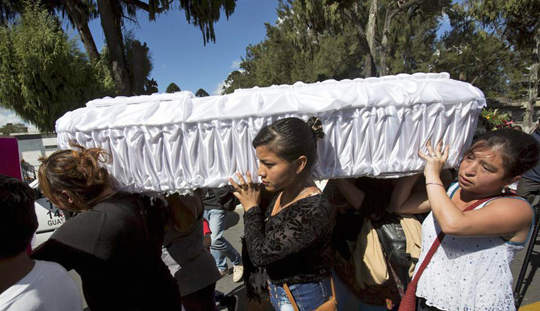Mar 22: When firefighters entered the home for troubled youth, they discovered more than two dozen girls on the floor of a locked room, most of them dead.

A moan rose from one of the bodies, piled on top of each other. When firefighter Danial Perpuac turned the girl over, flames came out of her mouth — she was burning up inside.
“That is something you cannot forget,” Perpuac said helplessly. “I know I will have the smell of grilled meat and hair in my nose and throat for life.”
The fire on March 8 that killed 40 girls at the Virgen de la Asunción Safe Home started when ringleaders took a match to a foam mattress to protest the abuse they had suffered there. Their hell at the government-run shelter began long before the inferno, as documented in several warnings from four different agencies. At least two orders for closure were ignored.
The Virgen de la Asunción home is on a hill 14 miles east of Guatemala City. The shelter, protected by high walls and barbed wire, is surrounded by an idyllic pine forest covered with mist every morning. The forest and ravines have offered hiding places for more than 100 children who have escaped what they consider a jail.
About 700 children — nobody knew exactly how many — lived in a home with a maximum capacity for 500. Some dormitories housed more than twice the number of children authorised for the space.
The majority had committed no crime. They were youths sent there by the courts for various reasons — they had run away from home, they were left in the streets, they were abused, they were young migrants. Most came from families so poor they could not afford the $50 in lawyers' fees to get their children out.
Once inside, the children lost out on schooling. Because of a lack of funds, their education was limited to six hours per week in classrooms with up to 80 students.
The abuse at Virgen de la Asunción was no secret, and the courts had intervened before. Teacher Edgar Rolando Diéguez Ispache has been in prison since 2013 and is on trial for alleged rape. Another employee, mason José Roberto Arias Pérez, has been in prison since 2014 for raping a mentally disabled girl. He was sentenced to eight years.
Several reports criticising the shelter were put out by the country's attorney general and the National Adoption System in 2015 and 2016. One recommended the gradual closure of the facility, and another its immediate closure.
Despite the complaints and the reports, the abuse continued.
The story of one girl who escaped the shelter on October 30, after six weeks inside, was told in a case file seen by The Associated Press. The girl, 16, is not named because she is an alleged victim of rape.
She fled from her own house in August to escape the extortion demands by a gang that had been threatening her with rape for a year. On August 13, she told her mother she had found a job and would be home late. Instead, she ran away to protect herself and her family.
“She hugged me tight that day, tighter than normal,” her mother said.
The mother reported her missing daughter to police. On August 22, they located the girl, and a youth court sent her to Virgen de la Asunción. Officials separated mother and daughter as they cried.
“Mama, get me out of here,” the girl begged, according to her mother.
The shelter did not have a procedure for visits, and they did not see each other for a month. By the time of a hearing on Sept. 13, the girl had been beaten, forced to get a tattoo with the name of a female staffer, and repeatedly raped, her mother said.
The first time, the female staff called her in for a physical exam and sedated her. She woke up and her whole body hurt, and she realised what they had done, according to the case file.
Several days later, they took her to the same place. This time, she was awake and tied to a gurney. The young man who raped her had his face covered.
The third time, it was several men, she said. They raped her and beat her.
A little more than two months after she was sent to the shelter, the daughter escaped along with three others. The girl was afraid to return home because that could mean being sent back to the shelter, but she contacted her brother. The family contacted their lawyer, who filed a motion for habeas corpus.
The lawyer managed to return the girl to her mother, but she didn't reveal all that had happened to her until after the fire. At that point, she said she wanted to testify against her abusers.
On November 11, the state attorney requested that the centre be closed. He asked that areas known as “the cage” and “the chicken coop” be closed within 48 hours. Both facilities looked like punishment cells, with metal doors and no windows.
Also in November, a state human rights prosecutor filed a complaint with the Inter American Human Rights Commission charging rampant abuses. The accusations included charges as serious as “forced recruitment for human trafficking for the purpose of prostitution”.
There were complaints about sexual abuse by male residents against female residents, including some under 13. One girl was killed in 2013, hanged with a scarf by two other girls.
On December 12, the Sixth Court of Children and Adolescents of the Metropolitan Area condemned the state of Guatemala for violations committed against the rights of minors guarded in the home. It also gave 48 hours to clarify the legal situation of a number of minors inside the home.
Nothing happened.
The secretary of social welfare, Carlos Rodas, who was responsible for the home, appealed the judicial decision. Rodas, who has since been arrested, has denied negligence and refused to resign. He blamed the girls' mutiny on them not liking the food, and said they had sharp weapons hidden in their hair.
“The problem is that judges mix children who have committed crimes with children abandoned by their families,” he said. “We ask the Public Prosecutor's Office to investigate but we do not directly blame anyone.”
On March 7, about 60 girls escaped from the shelter, as some had done on several occasions before. They rebelled because shelter staff had tried to beat them, said a 14-year-old survivor who had been there three months.
The girl, whose family did not want her name used out of fear for her safety, said she was not raped but officials took away her food. The girls also were made to wake up at 3am to bathe in cold water, she said.
So the girls jumped from the roof of the facility to the wall, and from there into the trees.
Riot police caught them and returned them to the shelter by force. The police sprayed pepper gas in their mouths and eyes, hit them with batons and kicked them, the 14-year-old told the AP. Police did not comment on the case because of a judicial order that prohibits discussion.
The angry teens waited outside the shelter for hours. They started throwing things at the police. Girls complained that they were abused, attacked and beaten.
The escapees eventually were brought in and locked in a 500-square-foot classroom as punishment. It is as yet unclear who locked them in and who held the key.
By 7:30 the next morning, they had been held for about six hours. They were not let out even to use the bathroom, the girl said.
Four girls who were ringleaders at the home had managed to get matches to smoke cigarettes during their brief escape. In an attempt to protest the lockup and force somebody to open the doors, they set fire to a mattress propped against a window.
The foam stuffing was already coming out of the mattresses because girls used it to fashion pads for menstruation when they didn't have anything else. The burning mattress fell onto other mattresses, and the flames quickly spread.
Locked into the room, the girls shouted, “Help me! Help me!” the 14-year-old said.
Nobody did.
“I saw how they burned, how they screamed, how they died,” she said.
She fainted. When she came to, somebody had finally opened the door. She ran out, and the staff doused the girls with water until ambulances arrived.
The girl suffered burns on both arms, a shoulder and part of her face. For many, it was too late. By 9am, 19 of the girls were dead, burned and asphyxiated. Twenty-one more between the ages of 13 and 17 would die at local hospitals over the next few days.
Kimberly Palencia Ortiz was one of the dead. The 17-year-old had been a ward of the state for nearly a year. Her father was in prison, her mother had disappeared, and her grandmother did not have the means to take care of her.
“It is an injustice,” Valeria Yojero said tearfully at her granddaughter's burial. “Nobody should die for being poor.”






Comments
Add new comment